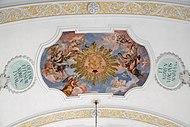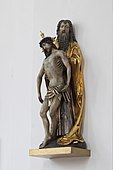St. Sixtus (Schliersee)
The Catholic parish church of St. Sixtus in Schliersee , a market town in the district of Miesbach in the administrative district of Upper Bavaria , was built in the early 18th century on the site of Romanesque and Gothic predecessor buildings in the Baroque style. The stucco work and ceiling frescoes are among the early works of Johann Baptist Zimmermann . The church is dedicated to Pope Sixtus II , who died a martyr in the 3rd century and is venerated as a saint.
history
The place Schliersee goes back to the foundation of a monastery ( Slyrse ) on the Kirchbichl, a hill between Hausham and Schliersee, around the year 770. The monastery was destroyed during the Hungarian invasions in the 10th century and re-founded in 1141 by Bishop Otto von Freising as a collegiate monastery on the banks of the Schliersee , on the site of today's parish church. The Romanesque monastery church fell victim to a fire in 1346. Two years later, Count Georg I von Hohenwaldeck had it rebuilt in the Gothic style.
In 1495, Duke Albrecht IV of Bavaria moved the Schliersee and Ilmmünster monasteries to the Frauenkirche in Munich, which was then newly built . From then on, pastoral care was provided by parish vicars sent by the collegiate chapter in Munich.
Johann Daller, who from 1704 held the office of parish vicar in Schliersee, campaigned for the new building of the church, which was marked by weather damage. Construction began in 1712 and was completed in 1714. In 1715 the consecration of the new church took place. Caspar Glasl was commissioned as master builder, and Johann Baptist Zimmermann was able to be won over for the stucco work and the frescoes .
architecture
The church is a hall with a retracted, semicircular closed choir . In the north of the west facade rises the bell tower, which was built in 1466 by the builders Alexander and Michael Gugler. Only the pointed helmet was put on after a lightning strike in 1873.
The nave is covered by a barrel cap with belt arches and divided by wide pillars with pilasters . The spaces between the wall pillars, vaulted by transverse barrels, are occupied by side chapels and equipped with altars .
Ceiling frescoes
The ceiling frescoes were made in 1714 by Johann Baptist Zimmermann.
In the choir they depict episodes from the life of St. Sixtus, the patron saint of the church. The two large scenes depict his capture in the presence of St. Lawrence , his deacon, and his beheading. The smaller pictures, executed in tone-on-tone painting, show St. Sixtus in dispute with ancient philosophers and in dungeon. They describe how idols burst before St. Sixtus and how he heals a blind man by giving him the blessing with the cross.
The nave frescoes are dedicated to the Christ monogram IHS and the Marian monogram, they are to be understood as praising the names of Jesus and Mary . The protective mantle Madonna sits enthroned above the organ loft and protects people of different classes such as a pope, a bishop, a king, a cardinal, nuns and ordinary people.
Furnishing
- On the north side of the choir is the Katharinenkapelle, still preserved from the medieval church, the burial place of the Lords of Waldeck . A red marble epitaph commemorates Georg von Waldeck, who died in 1380. The altar from the middle of the 17th century is decorated with the figures of the apostles Peter and Paul , who are older.
- The group of sculptures on the south wall of the choir represents the mercy seat . It is dated around 1480 and was created by Erasmus Grasser .
- The panel above the door to the sacristy shows a protective mantle Madonna. It is marked with the year 1494 and is attributed to Jan Polack .
- The late Gothic sculpture of Pope Sixtus enthroned in front of the main altar from around 1520 was a shrine figure on the previous altar . It was created by the master von Rabenden .
- The walnut high altar was made in 1717 based on a design by Johann Baptist Zimmermann. The two larger than life figures depict St. Benno von Meißen , the patron saint of the city of Munich, with his attributes , the fish and the keys, and St. Arsacius , whose relics are venerated in the Ilmmünster monastery. Arsacius is with the shrine of the three holy ones Kings depicted because - according to legend - he is said to have brought their bones from Constantinople to Milan.
- The pulpit dates from 1715.
- Numerous church chair signs have been preserved on the pews .
organ
Today's organ was built in 2012 by the Swiss company Mathis from Näfels and has 28 registers on two manuals and a pedal. It replaces a previous instrument made by Magnus Schmid in 1941. The Mathis organ has fully mechanical sliding chests and an additional electrical setting system. The disposition is as follows:
|
|
|
|||||||||||||||||||||||||||||||||||||||||||||||||||||||||||||||||||||||||||||||||||||||||||||||||||
-
Pairing :
- Normal coupling: II / I, I / P, II / P
- Sub-octave coupling: II / I, II / II
- Playing aids : 4000 typesetting combinations, mechanical collective step for plenary, mechanical collective step for reed voices
literature
- Georg Dehio : Handbook of German Art Monuments - Bavaria IV - Munich and Upper Bavaria . 2nd Edition. Deutscher Kunstverlag, Munich 2002, ISBN 3-422-03010-7 , p. 1078-1079 .
- Catholic Parish Office St. Sixtus (Ed.): 300 years St. Sixtus Schliersee . 2nd revised edition, Schliersee (without year and without ISBN).
Web links
- Schliersee, Collegiate Foundation St. Sixtus House of Bavarian History (accessed November 23, 2015)
Individual evidence
- ↑ Daniel Rimsl: Sigmund Haffner and the high altar to Rabenden . Schnell and Steiner, Regensburg 2015, ISBN 978-3-7954-2890-7 , pp. 58 f .
- ^ Presentation of the Mathis organ
Coordinates: 47 ° 43 '59.4 " N , 11 ° 51' 53.1" E











